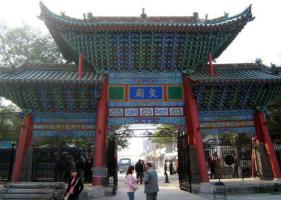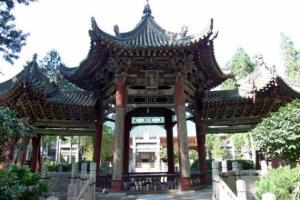Join-in Group Silk Road China Tours
About Us | Contact us | Tourist Map | Hotels | Feedback
Xian Attractions

Overview:Located on Zhongshan Street of Xianyang City, 28 km from Xian, the Xianyang Museum is a famous local history museum in China. Originally a Confucian Temple built in 1371, it was opened to the public in 1962 after reconstruction and expansion.
Located on Zhongshan Street of Xianyang City, 28 km from Xian, the Xianyang Museum is a famous local history museum in China. Originally a Confucian Temple built in 1371, it was opened to the public in 1962 after reconstruction and expansion.
Since Xianyang City was the capital of the Qin Dynasty (221BC - 206BC) and also the central location of the Han Dynasty (206BC-220) Mausoleums. Accordingly, the cultural relics in the Xianyang Museum focus on the Qin Dynasty and the Han Dynasty. Seven exhibition halls and a stele corridor of the museum house over 15,000 cultural artifacts, out of which 4,000 are now on display. Among the collections, the 3,000 Painted Terracotta Warriors and Horses of the Western Han Dynasty (206BC - 24AD) are the most famous.
The nine exhibition halls as follows:
No.1 - N0. 3 exhibition hall of the Xianyang Museum concentrate on the production tools, weapons, weights and measures, fine potteries, jade articles, Qin bricks and articles of daily use from the Qin Dynasty. Iron ploughs, iron hoes and other iron tools were widely used in the Qin kingdom between the Spring & Autumn Period and the Warring States Period. There is a suggestion that the metallurgical industry developed rapidly at that time. The extensive use of iron tools marked a new phase in the progress of productive forces.
No. 4 exhibition hall displays the paintings and calligraphies of contemporary famous persons. No. 5 and No. 6 exhibition halls show the world famous Painted Terra - Cotta Warriors and Horses of the Western Han Dynasty. The 3,000 figures comprised the great image of the royal guards of the Western Han Dynasty. This troop, full of power and grandeur, exemplifies the strength of the military power of the Western Han Dynasty. Displayed in Western Europe, North America, Japan and Singapore, this troop contributed much to carry forward the civilization of ancient China and promote the intercommunion between home and abroad.
On display in No. 7 exhibition hall are the cultural artifacts unearthed from the tombs of Western Han emperors. Nine out of the eleven Western Han emperors were buried in the area of Xianyang tableland. There are 500 tombs altogether, including the imperial mausoleums and their satellite tombs. The tombs are scattered in a range extending about 100 miles. Although they have not been excavated, cultural artifacts are occasionally discovered.
The eighth and ninth contain the biggest sitting bronze Buddha of the Ming Dynasty (1368-1644) in China as well as religion cultural relics.
Admission Fee: free
Opening Hours: 09:00-17:00 (Close on Mondays)
Address: No. 53, Zhongshan Street (Zhongshan Jie), Xianyang City, Shaanxi Province, China
Transportation: Take bus No.19, 25, 7, 39 (from the train station), 11, 12, 13, 14, 1, 59 (from Daqing Lu), 9; take Xianyang bus no.7, 19, or 24 to Bo Wu Guan (Museum) station.


